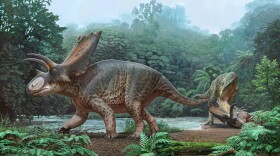A curious Ph.D student at the University of New Mexico has stumbled upon a new type of bird family after exhaustively testing the genetic makeup of two white-crowned shrikes found in central and southern Africa. And, as it turns out, these birds have been misclassified for centuries.
KUNM sat down with Jenna McCullough to chat about her discovery and how museums, along with the evolution of technology, made it all possible.
JENNA MCCULLOUGH: We had published a paper last year that looked at all songbirds species in this one clade called "corvides." That includes things like vangas, crows, drongos, or vireos. Those are species that you can find here in New Mexico. There's one particular branch that was behaving a bit oddly. And that was this species "eurocephalus." We wanted to do a follow-up study, to look at the species' relationships to the rest of crows, shrikes, and other species within this larger songbirds super family.
We collected a bunch of our data, collected a bunch more samples, and re-analyzed these relationships to find out that these two species have long been considered shrikes in the family laniidae, and we showed that they're actually not within laniidae and they're more closely related to crows and jays. What this means, in a taxonomic perspective, is that they would be considered their own family, because crows and jays are their own family, corvidae and shrikes are their own family laniidae, and these two birds didn't fit in either of those.
KUNM: How did you reach this point? You looked at genetics, right? The genome? How did that work?
MCCULLOUGH: Yeah. We sequenced a type of gene region called an ultra-conserved element. Across our genomes, there are these regions that, you know, aren't very long, you know, there's maybe 400 base pairs, which are like nucleotides, A,C, T, and G, that make up our DNA. And we had this set of genomic gene regions that are across a whole genome. And we did very complicated lab work to be able to get that data from samples of tissue samples from museum collections. So, we compare the different samples, their gene regions together to show that some are more closely related to others in evolutionary histories.
KUNM: Can you explain a little bit on how museums are really important when we research species like birds or different animals?
MCCULLOUGH: Museums, and not just the front part of the museums… Like, if you go downtown to the Natural History Museum, you see a lot of dioramas and things for education. The types of museums I'm talking about is what happens behind the scenes and a lot of those are specimens that have been collected around the world over the last 200 years. I like to talk about them like they are libraries. A library collects books, not knowing who's going to read them in the future, whether or not it's in the present like with this study. Each specimen is like a book, we can find things we can learn about their diet, about their bone structure, about their feathers, many different things go into what we can learn from a specimen.
KUNM: I do want to ask you what you think we can learn from birds, from someone like yourself who researches birds intimately, is around them a lot… What can we learn from them going forward?
MCCULLOUGH: There is so much that we can learn from birds. From a public level, people who spend a lot of time watching birds, it can be seen as a kind of meditation or being present seeing wildlife. We know that when the public and when people interact with wildlife more frequently, they become more invested in wildlife conservation and to conserve those species. That's important from a scientific perspective. But also, birds are in almost every habitat in the world. Maybe not like undersea habitats... But you can be in the middle of the ocean on a boat and see sea birds. You can be in caves in South America and see things like oil birds, and their ability to adapt to so many different environments. I think it really gives us a lot of insight into evolution, or overcoming adversity, which is a really great thing to learn about.



